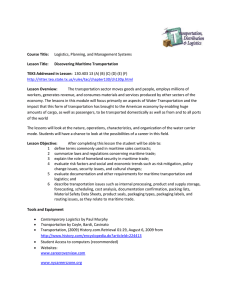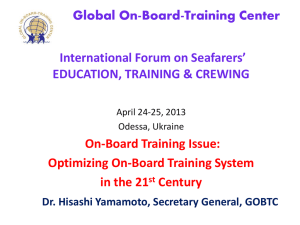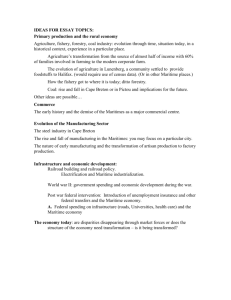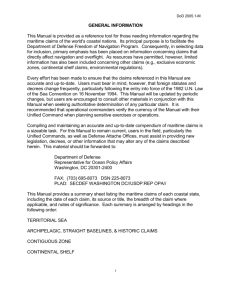Document 10398768
advertisement
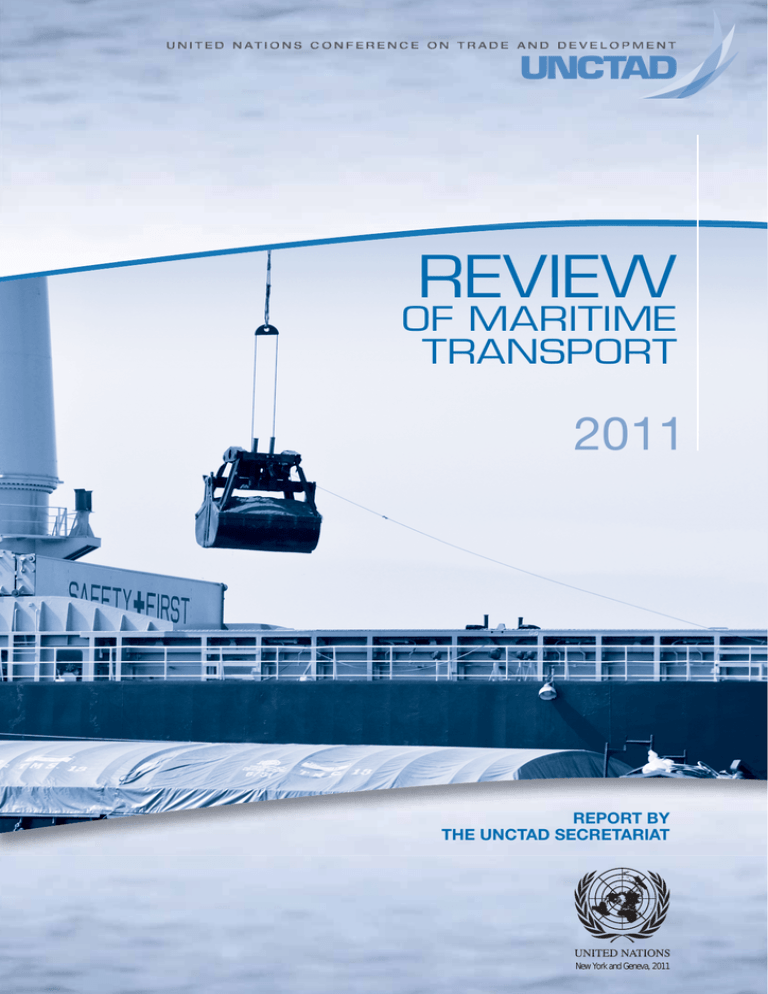
U N I T E D N AT I O N S C O N F E R E N C E O N T R A D E A N D D E V E L O P M E N T REVIEW OF MARITIME TRANSPORT 2011 REPORT BY THE UNCTAD SECRETARIAT New York and Geneva, 2011 Review of Maritime Transport 2011 ii NOTE The Review of Maritime Transport is a recurrent publication prepared by the UNCTAD secretariat since 1968 with the aim of fostering the transparency of maritime markets and analysing relevant developments. Any factual or editorial corrections that may prove necessary, based on comments made by Governments, will be reflected in a corrigendum to be issued subsequently. * ** Symbols of United Nations documents are composed of capital letters combined with figures. Use of such a symbol indicates a reference to a United Nations document. * ** The designations employed and the presentation of the material in this publication do not imply the expression of any opinion whatsoever on the part of the Secretariat of the United Nations concerning the legal status of any country, territory, city or area, or of its authorities, or concerning the delimitation of its frontiers or boundaries. * ** Material in this publication may be freely quoted or reprinted, but acknowledgement is requested, with reference to the document number (see below). A copy of the publication containing the quotation or reprint should be sent to the UNCTAD secretariat at the following address: Palais des Nations, CH‑1211 Geneva 10, Switzerland. UNCTAD/RMT/2011 UNITED NATIONS PUBLICATION Sales No. E.11.II.D.4 ISBN 978-92-1112841-3 ISSN 0566-7682 contents iii ACKNOWLEDGEMENTS The Review of Maritime Transport 2011 was prepared by the Trade Logistics Branch of the Division on Technology and Logistics, UNCTAD, under the coordination of Jan Hoffmann, the supervision of José María Rubiato, and the overall guidance of Anne Miroux. The authors were Regina Asariotis, Hassiba Benamara, Hannes Finkenbrink, Jan Hoffmann, Jennifer Lavelle, Maria Misovicova, Vincent Valentine and Frida Youssef. Administrative support and the desktop publishing were undertaken by Florence Hudry. Additional desktop publishing was carried out by Wendy Juan. Graphic support was provided by Philippe Terrigeol, and the publication was edited by Daniel Sanderson, Mike Gibson and Lucy Délèze-Black. This publication was externally reviewed by the following persons: Chapter 1: Socrates Leptos-Bourgi, Michael Tamvakis, Liliana Annovazzi-Jakab, Melissa Dawn Newhook. Chapter 2: Daniel S.H. Moon, Thomas Pawlik, Tengfei Wang. Chapter 3: Herman de Meester, Aleksandra Pieczek. Chapter 4: Sharmila Chavaly, Patrick Donner, Ki-Soon Hwang, Peter Marlow, Arvind Mayaram. Chapter 5: Mahin Faghfouri, Mia Mikic, André Stochniol. Chapter 6:Tilmann Boehme, Kevin Cullinane, Peter Faust, Maximilian Mrotzek, Hong-Oanh (Owen) Nguyen. Annexes: Desislava Oblakova. In addition, the publication was internally reviewed in full by Vladislav Chouvalov. Review of Maritime Transport 2011 iv CONTENTS Page Acknowledgements...................................................................................................................................... iii List of tables, figures and boxes................................................................................................................... v Abbreviations and explanatory notes............................................................................................................ ix Vessel groupings used in the Review of Maritime Transport.......................................................................... xiv Executive summary...................................................................................................................................... xv Chapter Page 1 Developments in international seaborne trade..................................................................................... 1 A.World economic situation and prospects.................................................................................... 2 B.World seaborne trade................................................................................................................. 7 C.Select emerging trends affecting international shipping ............................................................. 25 2. Structure, ownership and registration of the world fleet..................................................................... 35 A.Structure of the world fleet......................................................................................................... 36 B.Ownership and operation of the world fleet................................................................................ 41 C.Registration of ships................................................................................................................... 46 D.Shipbuilding, demolition and outlook on vessel supply............................................................... 51 3. Price of vessels and freight rates . ....................................................................................................... 63 A.Overview of the determinants of maritime transport costs and impact on trade ......................... 64 B.The price of vessels.................................................................................................................... 64 C.Freight rates............................................................................................................................... 65 4. Port and multimodal transport developments ..................................................................................... 85 A.Port developments .................................................................................................................... 86 B.Inland transport developments .................................................................................................. 94 C.Surface transport infrastructure development in developing countries......................................... 98 5. Legal issues and regulatory developments..........................................................................................109 A.Important developments in transport law . .................................................................................110 B.Regulatory developments relating to the reduction of greenhouse gas emissions from international shipping................................................................................................................113 C.Other legal and regulatory developments affecting transportation...............................................119 D.Trade facilitation in international agreements...............................................................................128 E.Status of conventions . ..............................................................................................................133 6. Developing countries’ participation in Maritime Businesses .............................................................143 A.Maritime business in developing countries..................................................................................144 B.Analysis of selected maritime businesses...................................................................................146 C.Comparative analysis of maritime businesses ........................................................................ .. 163 CONTENTS v Annexes I.Classification of countries and territories.........................................................................................172 II.World seaborne trade by country groups........................................................................................176 III. (a)Merchant fleets of the world by flags of registration, groups of countries and types of ship, as at 1 January 2011................................................................................................179 III. (b)Merchant fleets of the world by flags of registration, groups of countries and types of ship, as at 1 January 2011................................................................................................184 III. (c)Merchant fleets of the world by flags of registration, groups of countries and type of ship, as at 1 January 2011......................................................................................................................189 IV.True nationality of 20 largest fleets by flag of registration, as at 1 January 2011 .............................194 V.Container port throughput for maritime economies, 2008 and 2009...............................................201 VI.UNCTAD Liner Shipping Connectivity Index (LSCI) . .......................................................................204 VII. Countries’ market share in selected maritime businesses, per cent of world total...........................209 LIST OF TABLES, FIGURES AND BOXES Tables Page 1.1. World economic growth, 2007–2011............................................................................................. 3 1.2. Growth in the volume of merchandise trade, by geographical region, 2008–2010.......................... 6 1.3. Development of international seaborne trade, selected years......................................................... 7 1.4. World seaborne trade in 2006–2010, by type of cargo and country group..................................... 8 1.5. Oil and natural gas: major producers and consumers, 2010........................................................... 14 1.6. Major dry bulks and steel: major producers, users, exporters and importers, 2010........................ 19 1.7. Estimated cargo flows on major East–West container trade routes, 1995–2009............................. 23 1.8. Estimated cargo flows on major East–West container trade routes, 2008–2010............................. 24 2.1. World fleet size by principal types of vessel, 2010–2011................................................................ 37 2.2. Long-term trends in the cellular container ship fleet . ..................................................................... 39 2.3. Geared and gearless fully cellular container ships built in 2009 and 2010 ...................................... 39 2.4. Age distribution of the world merchant fleet, by vessel type, as at 1 January 2011 ...................... 41 2.5. The 35 countries and territories with the largest owned fleets (dwt), as at 1 January 2011............. 43 2.6. The 20 leading service operators of container ships, 1 January 2011............................................. 45 2.7. The 35 flags of registration with the largest registered deadweight tonnage, as at 1 January 2011.. 47 2.8. Distribution of dwt capacity of vessel types, by country group of registration, 2011........................ 48 2.9. Deliveries of newbuildings, different vessel types (2010) ................................................................ 52 2.10. Tonnage reported sold for demolition, different vessel types (2010) ............................................... 54 vi Review of Maritime Transport 2011 2.11. World tonnage on order, 2000–2010 . ........................................................................................... 56 2.12. Tonnage oversupply in the world merchant fleet , selected years . ................................................. 58 3.1. Representative newbuilding prices, 2003–2010............................................................................. 64 3.2. Second-hand prices for five-year-old ships, 2003–2010................................................................. 65 3.3. Tanker freight indices, 2009–2011.................................................................................................. 67 3.4. Tanker market summary: clean and dirty spot rates, 2009–2011.................................................... 69 3.5. Dry cargo freight indices, 2007–2011............................................................................................. 73 3.6. Container ship time charter rates................................................................................................... 77 3.7. Liner freight indices, 2007–2011.................................................................................................... 79 3.8. Cargo carried per deadweight ton of the total world fleet, selected years ...................................... 81 3.9. Estimated productivity of tankers, bulk carriers and the residual fleet, selected years..................... 82 4.1. Container port traffic for 76 developing countries and economic in transition: 2008, 2009 and 2010.............................................................................................................................. 87 4.2. Top 20 container terminals and their throughput for 2008, 2009 and 2010..................................... 89 6.1. Top 20 economies for shipbuilding, 2010 deliveries........................................................................147 6.2. Structure of ship imports and exports in the Republic of Korea, 2001 and 2010............................147 6.3. Top 20 ship orderbooks by country of ownership, 1 January 2011.................................................148 6.4. Brazilian-owned fleet, 1 January 2011............................................................................................149 6.5. The 20 largest containership-operating economies, January 2011.................................................150 6.6. Chilean ship operators...................................................................................................................150 6.7. Top 10 ship-scrapping nations, 2010.............................................................................................152 6.8. World’s largest ship-financing banks, total lending portfolio, 2009..................................................154 6.9. Lenders to COSCO . .....................................................................................................................155 6.10. Top 20 classification societies, 2010..............................................................................................155 6.11. Membership of the International Group of P&I Clubs......................................................................158 6.12. The 20 biggest suppliers of officers and ratings in 2010.................................................................159 6.13. Top 10 flags employing Philippine seafarers, and top 10 occupations of Philippines seafearers......160 6.14. Top 20 port operators, 2009..........................................................................................................161 6.15. Performance figures of Dubai Ports World......................................................................................162 6.16. Comparison of maritime sectors....................................................................................................164 6.17. Correlation analysis between maritime sectors and economic indicators........................................165 CONTENTS vii Figures 1.1. Indices for world GDP, the OECD Industrial Production Index, world merchandise trade and world seaborne trade (1975–2011)................................................................................................ 4 1.2. International seaborne trade, selected years.................................................................................. 10 1.3.(a) World seaborne trade, by country group and region, 2010............................................................. 11 1.3.(b) Participation of developing countries in world seaborne trade, selected years .............................. 12 1.4. Growth in five major dry bulks, 1982–2010.................................................................................... 17 1.5. Global container trade, 1990–2011................................................................................................ 22 1.6. Indices for global container, tanker, and major dry bulk volumes, 1990–2011 ................................ 23 2.1. World fleet by principal vessel types, selected years....................................................................... 36 2.2. World container fleet, selected years.............................................................................................. 40 2.3. Average age per ship, by vessel type, 10 major open registries ..................................................... 43 2.4. Share of foreign flagged fleet.......................................................................................................... 46 2.5. Vessel types registered in 10 major open registries, 2011............................................................... 49 2.6. Major countries of ownership and their flags of registration, 2011.................................................. 50 2.7. Major open and international registries and the countries of ownership, 2011................................ 50 2.8. Tonnage reported sold for demolition in 2010, by year of built ....................................................... 55 2.9. Average age of broken-up ships, by type, 1998 to 2010 ............................................................... 55 2.10. World tonnage on order, 2000–2010.............................................................................................. 58 2.11 Trends in surplus capacity by main vessel types, selected years..................................................... 59 3.1. Tanker freight market summary: various vessel sizes, 2003–2011.................................................. 68 3.2. Dry cargo freight indices, 2004–2011............................................................................................. 72 3.3. Baltic Exchange Dry Bulk Index, 2010–2011.................................................................................. 74 3.4. Growth of demand and supply in container shipping, 2000–2011.................................................. 76 3.5. New ConTex 2007–2011............................................................................................................... 78 3.6. Container prices (2005–2011)........................................................................................................ 80 3.7.Freight cost as a percentage of value of imports: long-term trend (1980-89, 1990-99 and 2000-09).................................................................................................. 80 3.8. Tons carried per deadweight ton (dwt) of the world fleet, selected years........................................ 82 4.1. Investment projects in transport (1990–2009)................................................................................. 99 4.2. Number of railway projects by region (1990–2009).........................................................................101 5.1. Increasing number of RTAs with trade facilitation measures (cumulative)........................................ 124 5.2. Overview of “WTO-like” trade facilitation measures under RTAs...................................................... 131 6.1. Export value of ships, boats and other floating structures............................................................... 132 6.2. Maritime sectors along a ship’s lifecycle.........................................................................................145 6.3. CSAV index on transported TEU, 1997–2010................................................................................151 viii Review of Maritime Transport 2011 6.4. Global marine finance loan volume ................................................................................................153 6.5. Panama-registered fleet 1995–2011..............................................................................................157 6.6. Regional focus of major port operators..........................................................................................162 6.7. Market-entry barriers into maritime businesses, for developing countries.......................................164 6.8. Linkages between maritime sectors...............................................................................................166 Boxes 4.1. The recent minerals boom and its impact on railway development in Africa.................................... 96 4.2. PIDA approved inter-connecting Africa railways networks projects development and implementation..............................................................................................................................103 4.3. Private-sector participation in African Railways...............................................................................104 5.1. The International Ship and Port Facilities Security Code ................................................................131 5.2. The New Inspection Regime under the Paris Memorandum of Understanding on Port State Control (Paris MoU).......................................................................................................132 5.3. Contracting States parties to selected conventions on maritime transport, as at 31 July 2011 ......134 LIST OF ABBREVIATIONS ix Abbreviations and explanatory notes AEO Authorized Economic Operator AfDB African Development Bank AGFUnited Nations Secretary-General’s High-level Advisory Group on Climate Change Financing AIS Automatic Identification System ASEAN Association of Southeast Asian Nations ATA actual time of arrival ATD actual time of departure ATL actual total loss BAF bunker adjustment factor bcm billion cubic metres BDI Baltic Exchange Dry Index BIMCO Baltic and International Maritime Council BIWTA Bangladesh Inland Water Transport Authority BLO build-lease-own BMP best management practice BOOT build-own-operate-transfer BOT build-operate-transfer BRIC Brazil, Russian Federation, India and China CBDR Common but Differentiated Responsibilities and Respective Capabilities CAC CRCC Africa Construction cbm cubic metre CO2 carbon dioxide COMESA Common Market for Eastern and Southern Africa CMR Convention on the Contract for the International Carriage of Goods by Road CRCC China Railway Construction Corporation CSAV Compañía Sudamericana de Vapores CSR corporate social responsibility CTL constructive total loss DBO design-build-operate DHS United States Department of Homeland Security DIS Danish International Ship Register DP World Dubai Ports World dwt deadweight ton Review of Maritime Transport 2011 x ECA emission control area ECDIS electronic chart display and information ECE United Nations Economic Commission for Europe ECLAC United Nations Economic Commission for Latin America and the Caribbean EIA United States Energy Information Administration EEDI Energy Efficiency Design Index EEOI Energy Efficiency Operational Indicator EFTA European Free Trade Association EORI Economic Operator Registration and Identification ESCAP United Nations Economic and Social Commission for Asia and the Pacific ETS emissions trading scheme EU European Union FEU 40-foot equivalent unit FTK freight ton-kilometre GATT General Agreement on Tariffs and Trade GDP gross domestic product GHG greenhouse gas GISIS Global Integrated Shipping Information System HPH Hutchison Port Holdings HRS high-risk ship HSBC Hongkong and Shanghai Banking Corporation IACS International Association of Classification Societies ICA Infrastructure Consortium for Africa ICC International Chamber of Commerce ICT information and communications technology IEA International Energy Agency IGP&I International Group of P&I Clubs ILO International Labour Organization IMB International Maritime Bureau IMO International Maritime Organization IRS Indian Register of Shipping ISO International Organization for Standardization ISPS International Ship and Port Facilities Security ISSC International Ship Security Certificate IT information technology km kilometre LIST OF ABBREVIATIONS xi LDC least developed country LLDC landlocked developing country LNG liquefied natural gas LPG liquefied petroleum gas LRS low-risk ship LSCI Liner Shipping Connectivity Index MARPOL International Convention for the Prevention of Pollution from Ships MBM market-based measure mbpd million barrels per day MDG Millennium Development Goal MEPC Marine Environment Protection Committee MFN most favoured nation MLC Maritime Labour Convention MLM Maritime Liens and Mortgages MoU Memorandum of Understanding MSC IMO Maritime Safety Committee MSM Maritime Security Manual MSWG Working Group on Maritime Security n.a. not available NEPAD New Partnership for Africa’s Development NIS Norwegian International Ship Register NYPE New York Produce Exchange OECD Organization for Economic Cooperation and Development OECS Organization of Eastern Caribbean States OPEC Organization of the Petroleum Exporting Countries P&I protection and indemnity PFSP Port Facility Security Plan PFSO Port Facility Security Officer PIDA Programme for Infrastructure Development in Africa PPP public–private partnership PSA Port of Singapore Authority RAKIA Ras Al Khaimah Investment Authority ro-ro roll-on roll-off RSO Recognized Security Organization RTA regional trade agreement SACU Southern African Customs Union Review of Maritime Transport 2011 xii SADC Southern African Development Community SAFE Framework of Standards to Secure and Facilitate Global Trade SAR Special Administrative Region SEEMP Ship Energy Efficiency Management Plan SIDS small island developing State SIN ship identification number SMEs small and medium-sized enterprises SoCPF Statement of Compliance of the Port Facility SOLAS International Convention for the Safety of Life at Sea SRS standard-risk ship SSA Ship Security Assessment SSAS Ship Security Alert System SSI Sustainable Shipping Initiative SSO Ship Security Officer SSP Ship Security Plan STCWInternational Convention on Standards of Training, Certification and Watchkeeping for Seafarers SVS–IP Small Vessel Security Implementation Plan SVSS Small Vessel Security Strategy TEU 20-foot equivalent unit THC terminal handling charge ULCC ultra-large crude carrier UNCITRAL United Nations Commission on International Trade Law UNCLOS United Nations Convention on the Law of the Sea UNDOALOS United Nations Division for Ocean Affairs and the Law of the Sea UNFCCC United Nations Framework Convention on Climate Change UN-OHRLLSUnited Nations Office of the High Representative for the Least Developed ­Countries, Landlocked Developing Countries and Small Island Developing States VES Vessel Efficiency System VHSS Hamburg Shipbrokers’ Association VIMSAS Voluntary IMO Member State Audit Scheme VLCC very large crude carrier VLOC very large ore carrier WCO World Customs Organization WS Worldscale WTO World Trade Organization *** xiii Explanatory notes • The Review of Maritime Transport 2011 covers data and events from January 2010 until June 2011. Where possible, every effort has been made to reflect more recent developments. • All references to dollars ($) are to United States dollars, unless otherwise stated. • Unless otherwise stated, “ton” means metric ton (1,000 kg) and “mile” means nautical mile. • Because of rounding, details and percentages presented in tables do not necessarily add up to the totals. • Two dots (..) indicate that data are not available or are not separately reported. • A hyphen (-) signifies that the amount is nil or less than half the unit used. • In the tables and the text, the terms countries and economies refer to countries, territories or areas. • Since 2007, the presentation of countries in the Review of Maritime Transport has been different from that in previous editions. Since 2007, the new classification is that used by the Statistics Division, United Nations Department of Economic and Social Affairs, and by UNCTAD in its Handbook of Statistics. For the purpose of statistical analysis, countries and territories are grouped by economic criteria into three categories, which are further divided into geographical regions. The main categories are developed economies, developing economies, and transition economies. See annex I for a detailed breakdown of the new groupings. Any comparison with data in pre-2007 editions of the Review of Maritime Transport should therefore be handled with care. Review of Maritime Transport 2011 xiv Vessel groupings used in the Review of Maritime Transport As in the previous year’s Review, five vessel groupings have been used throughout most shipping tables in this year’s edition. The cut-off point for all tables, based on data from Lloyd’s Register – Fairplay, is 100 gross tons (GT), except those tables dealing with ownership, where the cut-off level is 1,000 GT. The groups aggregate 20 principal types of vessel category, as noted below. Review group Constituent ship types Oil tankers Bulk carriers General cargo Oil tankers Ore and bulk carriers, ore/bulk/oil carriers Refrigerated cargo, specialized cargo, roll on-roll off (ro-ro) cargo, general cargo (single- and multi-deck), general cargo/passenger Fully cellular Oil/chemical tankers, chemical tankers, other tankers, liquefied gas carriers, passenger ro-ro, passenger, tank barges, general cargo barges, fishing, offshore supply, and all other types Includes all the above-mentioned vessel types Container ships Other ships Total all ships Approximate vessel size groups referred to in the Review of Maritime Transport, according to generally used shipping terminology Crude oil tankers ULCC, double-hull ULCC, single hull VLCC, double-hull VLCC, single hull Suezmax crude tanker Aframax crude tanker Panamax crude tanker 350,000 dwt plus 320,000 dwt plus 200,000–349,999 dwt 200,000–319,999 dwt 125,000–199,999 dwt 80,000– 124,999 dwt; moulded breadth > 32.31m 50,000– 79,999 dwt; moulded breadth < 32.31m Dry bulk and ore carriers Large capesize bulk carrier Small capesize bulk carrier Panamax bulk carrier Handymax bulk carrier Handysize bulk carrier 150,000 dwt plus 80,000–149,999 dwt; moulded breadth > 32.31 m 55,000–84,999 dwt; moulded breadth < 32.31 m 35,000–54,999 dwt 10,000–34,999 dwt Ore/oil Carrier VLOO 200,000 dwt Container ships Post-Panamax container ship Panamax container ship moulded breadth > 32.31 m moulded breadth < 32.31 m Source: IHS Fairplay. executive summary xv EXECUTIVE SUMMARY Developments in international seaborne trade The world economic situation has brightened in 2010. However, multiple risks threaten to undermine the prospects of a sustained recovery and a stable world economy – including sovereign debt problems in many developed regions, and fiscal austerity. These risks are further magnified by the extraordinary shocks that have occurred in 2011, which have included natural disasters and political unrest, as well as rising and volatile energy and commodity prices. Given that for shipping, all stands and falls with worldwide macroeconomic conditions, the developments in world seaborne trade mirrored the performance of the wider economy. After contracting in 2009, international shipping experienced an upswing in demand in 2010, and recorded a positive turnaround in seaborne trade volumes especially in the dry bulk and container trade segments. However, the outlook remains fragile, as seaborne trade is subject to the same uncertainties and shocks that face the world economy. Structure, ownership and registration of the world fleet The year 2010 saw record deliveries of new tonnage, 28 per cent higher than in 2009, resulting in an 8.6 per cent growth in the world fleet. Deliveries amounted to 11.7 per cent of the existing fleet; the previous peak had been in 1974, when deliveries amounted to approximately 11 per cent of the existing fleet. The world merchant fleet reached almost 1.4 billion deadweight tons in January 2011, an increase of 120 million dwt over 2010. New deliveries stood at 150 million dwt, against demolitions and other withdrawals from the market of approximately 30 million dwt. Since 2005, the dry bulk fleet has almost doubled, and the containership fleet has nearly tripled. The share of foreign-flagged tonnage reached an estimated 68 per cent in January 2011. The surge in vessel supply is the result of orders placed before the economic crisis. This, combined with lowerthan-expected demand, has led to a situation where there is an excess supply of shipping capacity. In the dry bulk and container sectors especially, analysts forecast an oversupply of tonnage in coming years. In both sectors, recent and upcoming record-sized newbuildings pose a further challenge to owners, who will need to find cargo to fill their ships. Price of vessels and freight rates The price of newbuildings was lower for all vessels types in 2010, reflecting market views that the capacity of the world fleet is sufficient to meet world trade in the short-term. In the second-hand market, the results were mixed. The larger oil tankers held their value, while smaller tankers and specialized product tankers declined in value. In the dry bulk sector, the price of medium-sized Panamax vessels decreased, while the price of smaller and larger vessels increased. The price for all sizes of secondhand container ships also rose in value during 2010 as trade volumes recovered. Freight rates in the tanker sector performed better than the previous year, rising between 30 and 50 per cent by the end of 2010. Every month for all vessel types was better than the corresponding month for the previous year. However, tanker freight rates in general still remained depressed, compared with the years immediately preceding the 2008 peak. Freight rates in the dry bulk sector performed well for the first half of the year, but the Baltic Exchange Dry Index (BDI) lost more than half its value from the end of May 2010 to mid-July 2010. A partial rally occurred in August 2010 before the Index continued its downward trajectory. Between May 2010 and May 2011, the BDI declined by about two thirds. Container freight rates in 2010 witnessed a major transformation brought about by a boost in exports and measures introduced by shipowners to limit vessel oversupply. The result can be seen in the New ConTex Index, which tripled in value from early 2010 to mid-2011. Port and multimodal transport developments World container port throughput increased by an estimated 13.3 per cent to 531.4 million TEUs in 2010 after stumbling briefly in 2009. Chinese mainland ports continued to increase their share of total world container port throughput to 24.2 per cent. The xvi UNCTAD Liner Shipping Connectivity Index (LSCI) reveals that China continues its lead as the single most connected country, followed by Hong Kong SAR, Singapore and Germany. In 2011, 91 countries increased their LSCI ranking over 2010, 6 saw no change, and 65 recorded a decrease. In 2010, the rail freight sector grew by 7.2 per cent to reach 9,843 billion freight ton kilometres (FTKs). The road freight sector grew by 7.8 per cent in 2010 over the previous year with volumes reaching 9,721 billion FTKs. Legal issues and regulatory developments Important legal issues and recent regulatory developments in the fileds of transport and trade facilitation included the entry into force on 14 September 2011 of the International Convention on Arrest of Ships, which had been adopted at a joint United Nations/International Maritime Organization (IMO) Diplomatic Conference held in 1999 under the auspices of UNCTAD. Moreover, during 2010 and the first half of 2011, ­important discussions continued at IMO regarding the scope and content of a possible international regime to control greenhouse gas (GHG) emissions from international shipping. Finally, there were a number of regulatory developments in relation to maritime security and safety, as well as in respect of trade facilitation agreements at both the multilateral and the regional levels. Review of Maritime Transport 2011 Developing countries’ participation in Maritime Businesses Developing countries are expanding their participation in a range of different maritime businesses. They already hold strong positions in ship scrapping, ship registration, and the supply of seafarers, and they have growing market shares in more capital-intensive or technologically advanced maritime sectors such as ship construction and shipowning. China and the ­Republic of Korea between them built 72.4 per cent of world ship capacity (dwt) in 2010, and 9 of the 20 largest countries in shipowning are developing countries. Ship financing, insurance services and vessel classification are among the few maritime ­sectors that have so far been dominated by the more advanced ­economies. However, here, too, developing countries have ­recently ­demonstrated their potential to become major market ­players. India, for instance, joined the International Association of ­Classification Societies; through this it gains easier access to the global ship classification market. China now has two of the world’s largest banks in ship financing.

